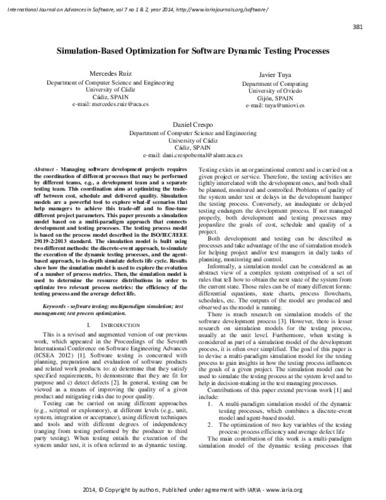Simulation-based optimization for software dynamic testing processes
Autor(es) y otros:
Palabra(s) clave:
Software testing
Multiparadigm simulation
Fecha de publicación:
Editorial:
IARIA
Citación:
Descripción física:
Resumen:
Managing software development projects requires the coordination of different processes that may be performed by different teams, e.g., a development team and a separate testing team. This coordination aims at optimizing the tradeoff between cost, schedule and delivered quality. Simulation models are a powerful tool to explore what-if scenarios that help managers to achieve this trade-off and to fine-tune different project parameters. This paper presents a simulation model based on a multi-paradigm approach that connects development and testing processes. The testing process model is based on the process model described in the ISO/IEC/IEEE 29119-2:2013 standard. The simulation model is built using two different methods: the discrete-event approach, to simulate the execution of the dynamic testing processes, and the agentbased approach, to in-depth simulate defects life cycle. Results show how the simulation model is used to explore the evolution of a number of process metrics. Then, the simulation model is used to determine the resource distributions in order to optimize two relevant process metrics: the efficiency of the testing process and the average defect life
Managing software development projects requires the coordination of different processes that may be performed by different teams, e.g., a development team and a separate testing team. This coordination aims at optimizing the tradeoff between cost, schedule and delivered quality. Simulation models are a powerful tool to explore what-if scenarios that help managers to achieve this trade-off and to fine-tune different project parameters. This paper presents a simulation model based on a multi-paradigm approach that connects development and testing processes. The testing process model is based on the process model described in the ISO/IEC/IEEE 29119-2:2013 standard. The simulation model is built using two different methods: the discrete-event approach, to simulate the execution of the dynamic testing processes, and the agentbased approach, to in-depth simulate defects life cycle. Results show how the simulation model is used to explore the evolution of a number of process metrics. Then, the simulation model is used to determine the resource distributions in order to optimize two relevant process metrics: the efficiency of the testing process and the average defect life
ISSN:
Colecciones
- Artículos [37532]
- Informática [872]
Ficheros en el ítem





